Water Quality and Concentrated Animal Feeding Operations
Concentrated animal feeding operations (CAFOs) are colossal facilities where thousands of animals are raised for consumption. In the United States, North Carolina is one of the top players when it comes to the production of swine and poultry by using these types of operations. But, with that high ranking comes high risks for North Carolinians.
>> Download full copy of Mission: Water Magazine
>> Download Combating CAFOs from Mission: Water Magazine
North Carolina produces the second most hogs of any state in the country. The state is home to more than 2,200 swine CAFOs that confine an estimated 10 million hogs. Parts of the state have the highest density of hog operations in the world. In addition to hog operations, North Carolina produces approximately 785.5 million broiler chickens per year, the fourth most of any state, and approximately 34 million turkeys, the second most of any state.
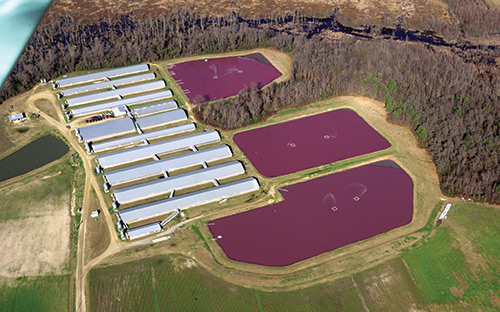
Massive facilities require massive waste management systems, like these treatment pools, which present a variety of environmental risks.
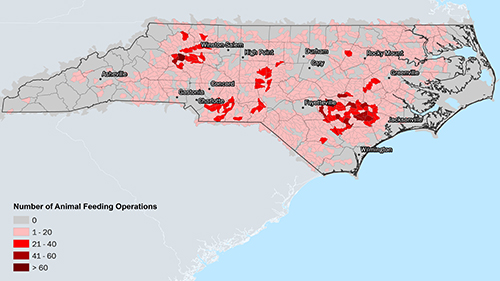
Density of Animal Feeding Operations. Learn more at EWG Interative Maps.
The problem that arises when raising a large number of animals in a limited space is simple enough: animals generate waste, but there is nowhere to put it. For hog and cattle operations, which produce wet waste, the urine and feces generated are collected in open-air, unlined pits often the size of Olympic swimming pools. Across the state, there are over 15,000 of these cesspools brimming with swine waste.
After the wet waste is collected in these pits, it is sprayed onto adjacent fields. In North Carolina, many of these fields are in low-lying coastal plains with a high groundwater table, where the fields have been heavily ditched for proper drainage to facilitate crop production. Compounding the problem, the waste is often sprayed in amounts far greater than can be absorbed by crops.

Swine waste is regularly discharged directly to surface waters.
The ditches in the fields act as conduits for pollutants such as nutrients (like nitrogen and phosphorous that lead to harmful algal blooms [Learn more about Algae Blooms]) and fecal bacteria. These pollutants are transported off-site and into public waters. Heavy rainfall or high winds can also transport pollution into surface waters. In addition to these impacts on water quality, CAFOs emit foul odors and air pollution in the form of toxic substances like ammonia and hydrogen sulfide as well as greenhouse gases like methane.
Because of their waste management practices, some CAFOs pose an imminent threat to public health and the environment in North Carolina, especially whenever a major tropical storm or hurricane hits the state. Even the best-run CAFO can’t stop rising floodwaters from transporting waste from inundated sprayfields or breached lagoons into public waterways. The water pollution in the state has reached such an extreme level that American Rivers listed the Neuse and Cape Fear Rivers (the source of drinking water for 40% of North Carolinians) among their list of America’s Most Endangered Rivers® for 2017. The reason they were listed so high? Because of the significant number of CAFOs in the rivers’ floodplains.
Pollution from CAFOs doesn’t just threaten the environment, it lowers the quality of life for many North Carolinians. Many scientific studies have confirmed and documented the numerous health effects associated with living near CAFOs in North Carolina. Waterborne health threats range from the spread of disease through pathogens and bacteria in the water, to methemoglobinemia (blue-baby syndrome) caused by high nitrate levels in water. Airborne threats include asthma and other respiratory disorders, which are common especially in the young and elderly, as well as exposure to antibiotic-resistant bacteria such as methicillin-resistant staphylococcus aureus (MRSA). Emissions of hazardous gasses from CAFOs are linked to coughing, nausea, headaches, burning eyes, and psychological impairments.
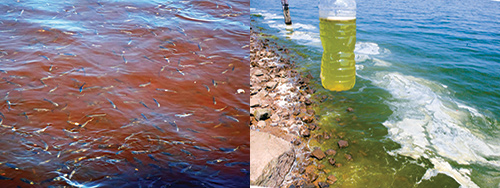
Raw swine discharges have serious implications including fish kill and algal blooms.
“Riverkeepers are...working tirelessly to keep our rivers, lakes and streams clean."
WATERKEEPER® ALLIANCE Gets Down and Dirty to Reel in Wins Against CAFO Pollution
Waterkeeper Alliance’s Pure Farms, Pure Waters campaign focuses on educating the public and decision makers about the impacts of and alternatives to industrialized livestock operations, supporting communities and local farmers, and advocating for sustainable food systems. We implement the campaign in coordination with local environmental organizations across the state that house Riverkeepers – experienced advocates devoted to protecting a specific waterbody in their community.
North Carolina communities need support because beyond being a public health issue, this is an environmental justice epidemic. Across the state, swine CAFOs are disproportionately located in low-income communities and communities of color. The percentage of people of color living within three miles of an industrial hog operation is 1.52 times higher than the percentage of non-Hispanic Whites. In September 2014, Waterkeeper Alliance took action against this injustice in partnership with the NC Environmental Justice Network (NCEJN) and the Rural Empowerment Association for Community Help (REACH).
These groups filed a complaint with the U.S. Environmental Protection Agency’s (EPA) External Civil Rights Compliance Office (ECRCO) against North Carolina Department of Environmental Quality (NCDEQ), alleging that the state agency violated Title VI of the Civil Rights Act of 1964 by issuing a permit that allowed for the operation of over 2,200 industrial hog facilities without sufficient protections to affect neighboring residents. Title VI prohibits recipients of federal funds - such as the North Carolina government - from taking actions that have a discriminatory racial impact.
The challenged permit did not give adequate protections for the African American, Hispanic and Native American communities that bear the burden of living next to these polluting operations. The agency nonetheless issued the permits despite extensive evidence demonstrating the negative impacts of the continued use of primitive waste management techniques.
ECRCO began its investigation of the complaint in February 2015. This year, in a January 12th letter to NCDEQ, the agency expressed “deep concern” that the state’s failure to adequately regulate industrial hog operations has a disparate, discriminatory impact on communities of color in eastern North Carolina.
>> Download Combating CAFOs from Mission: Water Magazine
EPA’s “Letter of Concern” urged NCDEQ to take immediate steps to address the discriminatory effects of the state’s swine waste management system. “For far too long, NCDEQ has prioritized customer service for the benefit of polluters instead of environmental protection for the benefit of all North Carolinians,” says Will Hendrick, Waterkeeper Alliance Staff Attorney, and Manager of its North Carolina Pure Farms, Pure Waters Campaign. “We are glad EPA shared our concerns and are hopeful that the new NCDEQ administration will view this as an opportunity to take long overdue action.”
The letter to NCDEQ contained key recommendations that the state agency should take, with immediate steps to be implemented. EPA acknowledged that alternative waste management technologies are available and would decrease pollution and odor caused by the use of lagoon and sprayfield systems. EPA further called on NCDEQ to institute a “functioning nondiscrimination program,” including the introduction of staff and procedures to handle complaints from the public. NCEJN, REACH, and Waterkeeper Alliance hope that NCDEQ will adopt these recommendations.
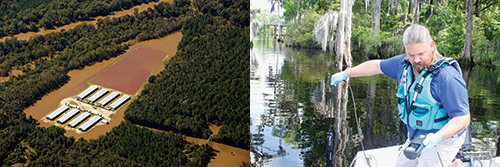
Flooding from Hurricane Matthew in October 2016 compromised CAFO industrial waste ponds (Left). Monitoring programs undertaken by WATERKEEPER® ALLIANCE ensure compliance with local laws (Right).
The letter from EPA to NCDEQ was a critical step toward achieving justice and recently Waterkeeper Alliance was able to put another win under its belt in Waterkeeper Alliance v. Environmental Protection Agency. On April 11, 2017, the DC Circuit Court ordered EPA to close a dangerous loophole that has allowed hazardous substances released into the environment by CAFOs to go unreported. “People have a right to know if CAFOs are releasing hazardous substances that can pose serious risks of illness or death,” says Kelly Foster, Senior Attorney for Waterkeeper Alliance. “This ruling ensures that the public will be able to obtain this information in the future, and will hopefully spur EPA to start responding when hazardous substances reach toxic levels.”
Responding to Pollution Disasters
Waterkeeper Alliance has created a “Rapid Response” initiative to guide its response to environmental disasters. This ”Rapid Response” program is an innovative solution that has provided trusted and independent emergency response to disasters impacting waterways in North Carolina. The program is focused on documenting and reporting impacts to the public and governmental agencies. Waterkeeper Alliance and North Carolina Riverkeepers utilized the model with full efficacy when Hurricane Matthew throttled the state in October 2016.
Responders immediately captured photos that showed the submersion of sprayfields and breach of waste ponds at industrial hog facilities throughout the coastal plain. They closely monitored industrial meat production facilities where threats to water quality and human health increased as floodwaters inundated fields, drowned animals in barns, and overwhelmed waste lagoons. The impact of Hurricane Matthew was exacerbated by the presence of so many CAFOs in the floodplain.
“Waterkeeper Alliance and its Riverkeepers are the eyes and ears on the ground, working tirelessly to keep our rivers, lakes, and streams clean,” says Will Hendrick. Without Waterkeeper Alliance and the Riverkeepers efforts, the people of North Carolina would not have been aware of the pollution from industrial facilities for quite some time. Riverkeepers were among the first responders to this environmental disaster. They were able to quickly get data on the pollution and its harmful effects to surrounding communities so residents could protect themselves.
As climate change causes even more of these destructive weather events, we cannot afford continued disasters to North Carolina’s waterways and communities.
Waterkeepers are pressuring the state legislature to re-invest in the removal of CAFOs from the 100-year floodplain, which would significantly reduce the threat to our water resources and communities posed by these facilities. As a result of our advocacy following Hurricane Matthew, the NC General Assembly allocated more than $2M to fund the voluntary closure of swine facilities in the flood plain. This was the first investment in the facility closure program in a decade.
Achievements of this magnitude are made possible by a dedicated team of Riverkeepers throughout the state who monitor the impact of CAFO pollution on our waters. The 14 Waterkeeper Organizations and Affiliates in North Carolina spend every day standing up to polluters and protecting local waterways.
One such Riverkeeper is Cape Fear Riverkeeper, Kemp Burdette. His watershed contains 40 swine and 11 poultry CAFOs, equaling approximately 94,000 head of swine and 1.3 million broiler chickens. For essential water monitoring, Burdette relies on YSI instruments to provide quick and accurate water-quality data that he uses to identify waterways that are in trouble. He recently located a heavily impaired waterway, which he expects to be added to North Carolina’s 303(d) list of impaired water bodies because of his collection and submission of data demonstrating high concentrations of bacteria. Once listed as impaired, a watershed-wide approach to reducing pollution can be planned and implemented to fix issues in the waterbody.
Waterkeepers are watchdogs that carry out air, ground, and water monitoring on a weekly basis. They patrol in small aircraft overhead to identify facilities breaking the rules and target where to later perform water quality tests. They use YSI water quality monitoring equipment to test pollution levels in waterways and locate the source of pollution. Yadkin Riverkeeper, Will Scott, says YSI equipment is critical to his organization because it “helps us be mobile to monitor water quality across our whole 7,221 square mile watershed.” Waterkeepers are the ones in the field collecting the data needed to hold polluters accountable."
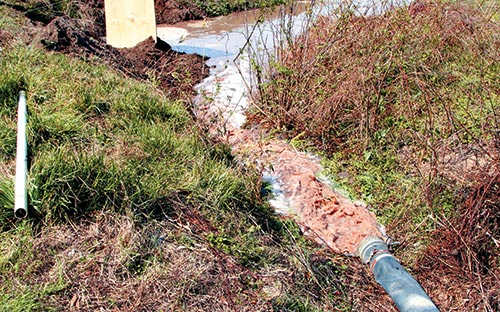
Illegal swine waste discharge, shown above, is being pumped into the tributary system upstream of the CAFO facility and is the leading reason for the WATERKEEPER® ALLIANCE monitoring program.

Conclusion
At both the state and federal levels, efforts are underway to roll back environmental regulations and impose extensive budget cuts on environmental agencies. In such a climate, the need for Waterkeepers to speak the truth about the harmful impacts of water emergencies on communities has never been greater. Data collection by Riverkeepers has proven to be a successful way to advocate for policy changes. North Carolina Riverkeepers will remain involved as long as necessary to assure the health and safety of the state’s waterways and communities.
About WATERKEEPER® ALLIANCE
Waterkeeper Alliance strengthens and grows a global network of grassroots leaders protecting everyone’s right to clean water. It is a global movement uniting more than 300 Waterkeeper Organizations and Affiliates on six continents and focusing citizen advocacy on issues that affect our waterways, from pollution to climate change. Waterkeepers patrol and protect more than 2.5 million square miles of rivers, streams and coastlines in the Americas, Europe, Australia, Asia and Africa.
Web: waterkeeper.org
Facebook: facebook.com/waterkeeper
Twitter: @waterkeeper
Instagram: @waterkeeperalliance
